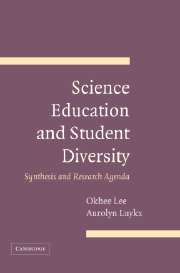Book contents
- Frontmatter
- Contents
- Foreword by Roland G. Tharp
- Acknowledgments
- Introduction
- SECTION I CONCEPTUAL GROUNDING AND POLICY CONTEXT
- SECTION II STUDENT LEARNING AND CLASSROOM PRACTICES
- SECTION III CREATING EQUITABLE LEARNING ENVIRONMENTS
- SECTION IV CONCLUSIONS AND A RESEARCH AGENDA
- Appendix: Method for Research Synthesis
- References
- Index
SECTION II - STUDENT LEARNING AND CLASSROOM PRACTICES
Published online by Cambridge University Press: 04 December 2009
- Frontmatter
- Contents
- Foreword by Roland G. Tharp
- Acknowledgments
- Introduction
- SECTION I CONCEPTUAL GROUNDING AND POLICY CONTEXT
- SECTION II STUDENT LEARNING AND CLASSROOM PRACTICES
- SECTION III CREATING EQUITABLE LEARNING ENVIRONMENTS
- SECTION IV CONCLUSIONS AND A RESEARCH AGENDA
- Appendix: Method for Research Synthesis
- References
- Index
Summary
In an attempt to address the gaps in science outcomes (broadly defined), this synthesis highlights factors related to students' race/ethnicity, culture, language, and social class. Some studies examine relationships between these factors and student outcomes; particularly, experimental studies offer causal explanations of the impact of treatments or interventions on science outcomes. Others explicate underlying processes involving student diversity in science teaching and learning. In this section, we present the results of research focusing on classroom practices: (a) student characteristics and science learning, (b) science curriculum (including computer technology), (c) science instruction, and (d) science assessment. Studies addressing bilingual or ELL students are discussed within each section. Some studies addressed multiple topics and thus are included in more than one area. In describing specific studies, we address research questions, theoretical perspective or conceptual framework, methods (e.g., research setting, participants, data collection and analysis), results, and conclusions.
- Type
- Chapter
- Information
- Science Education and Student DiversitySynthesis and Research Agenda, pp. 31 - 32Publisher: Cambridge University PressPrint publication year: 2006



